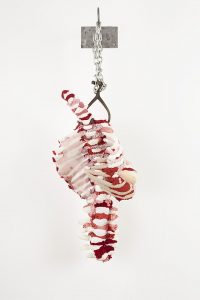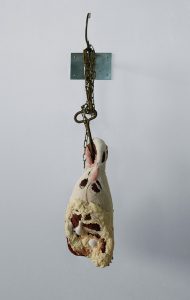Curators' Pick
TAMARA KOSTIANOVSKY | ACTUS REUS

Tamara Kostianovsky | Actus Reus
I am afraid the good woman did not realize how difficult it is to cut up a body, never having done so herself. (Margaret Atwood, Alias Grace)
To the Puritan all things are impure, as somebody says. (D.H. Lawrence, Sketches of Etruscan Places)
Tamara Kostianovsky’s artworks are disquieting; that is meant as praise. What her sculptures in the body of work titled Actus Reus – both specific elements and the larger installations of multiple components – do is allude, and we do the rest. What we initially ‘think’ we’re looking at is not at all what we’re truly observing. An initial revulsion turns to seduction, and we find ourselves drawn in by both the formal attraction as well as the conceptual fracture that only makes her work more enticing.
It’s almost appropriate, then, that one of the works that comprises Actus Reus is titled Abnegation (which means “the act of renouncing or rejecting something”); or that the name of the series itself is a ‘criminal’ legal term. Actus Reus is “sometimes called the external element or the objective element of a crime….the Latin term for the “guilty act” which, when proved beyond a reasonable doubt in combination with the mens rea, “guilty mind”, produces criminal liability in the common law−based criminal law jurisdictions of numerous countries….” There is almost a culpability in our own interactions with these artworks…..
Other works in this series – What It Once Was (2011), One and a Half (2008), Bound (2008), Venus (2011), Elegy (2009) – all leave the viewer feeling as though they’re looking upon – and enjoying gazing upon, devouring with their eyes – something that is forbidden, not meant to be seen, and definitely not be enjoyed, as though illicitly consuming visual pleasure from them….
Before I delve further into my interpretations of Kostianovsky’s work, her statement is as follows: The discovery of a world concealed behind the skin took form in my adolescence while working at a surgeon’s office, where veins exploded into waterfalls, cut ligaments set free the muscles they once contained, and chunks of fat poured over tissues of various colors and textures. A fascination with these encounters put the body at the center of my work, allowing me to use this imagery to reflect on consumption, ecology, and the voracious needs of the body.
- Abnegation, 2008
- What it Once Was, 2011
- Venus, 2011
- Intertwined, 2010
Jana Sterback’s Vanitas: Flesh Dress for an Albino Anorectic (1987) which was a garment made from 23 kilos of salt-cured raw flank steak, sewing thread, salt and metal, alternately worn by a model while fresh and later to be displayed on a dressmaker’s dummy as it rotted and stank and festered, comes to mind. Andres Serrano’s richly, bloodily red severed calf’s head – safely sanitized in as one of his visually delectable C Prints – titled Cabeza De Vaca (1984) for the rapacious Spanish Conquistador of the same title, must also be considered when engaging with Kostianovsky’s contrastingly bloodless tableaux. Many, oh so many paintings by Francis Bacon or Chaïm Soutine (Carcass of Beef, 1925, for example) stand like ancestors behind Kostianovsky’s art. Perhaps we’ve stepped into the same room that the blind, toothy figure from Bacon’s Untitled (1946) haunts, like a denizen of another level of Dante’s Inferno. Maybe the environments that Kostianovsky proffers are the interiors, the worlds ‘made flesh’, that we saw painted in Bacon’s numerous crucifixions.
Or these are Soutine’s rendered in three dimensions, with colours just as raw, and with that same alarming allure. I feel it’s appropriate to cite all these artists who employed the symbolism of meat and flesh – often to hint at, or imply larger issues – as Kostianovsky speaks of this in her own comments about her art: Inspired by Art History, memories of butchered meat I saw while growing up in Argentina, and the mechanized systems of consumption that dominate the production of goods in the United States, my work proposes a type of beauty that integrates our corporeal realities to the contemporary systems of industrialization that devour them.
- Abacus, 2008
- Abacus, 2008
- Elegy, 2009
- Elegy (detail), 2009
To return to the term Actus Reus, I’ll inject another consideration: the painter Francis Bacon often spoke of how he used the term ‘crucifixion’ as a generic term for something terrible happening that others stop to watch…
But there’s a confutation: many of the ‘sides of beef’ that hang on meat hooks are ‘dressed’ in delicate patterns, sometimes distressingly floral and decorative, more like a fine flocked wallpaper you’d find in a Victorian lady’s drawing room. The yellows or reds that might be initially seen as fat and flesh are, in fact, anything but that. Kostianovsky’s words, again: Garments from my own wardrobe make up the bulk of the material I use in my fabric work. Committed to giving a second chance in the world to rejected articles of clothing and other domestic textile items, I periodically cannibalize my own wardrobe looking to find supplies to create sculptures with. A type of alchemy happens in my studio, where discolored undergarments are transformed into ligaments, stained tablecloths assume the color and texture of exotic bird feathers, and over worn sweaters unravel into the rich textures of animal fat. By contrasting a visceral imagery with soft materials, I seek to reintegrate the physicality of our bodies and the natural processes of birth, growth, and decay back into our existential understanding of life.
A teacher of mine – and a fine artist – once described exhibiting her work as akin to hanging your skin on the wall, as it was so personal – like your own clothing, and that consideration is in play here, as well.
You can enjoy more works from this series here, and Tamara’s main site is here.
~ Bart Gazzola







